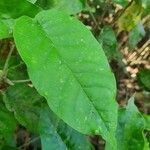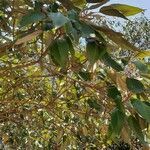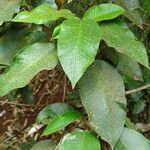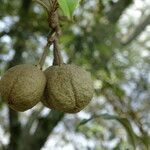A large monoecious or occasionally dioecious tree up to 35 m. tall, though commonly 15–25 m., with a clear bole up to 20 m. high and 1 m. diameter and a spreading crown; bark pale grey-brown, closely longitudinally fissured.. Young twigs densely fulvous lepidote to fulvous or ferruginous stellate-lepidote.. Older twigs greyish brown, tardily glabrescent.. Petioles 2–8(–11) cm. long, densely fulvous lepidote to fulvous or ferruginous stellate-lepidote; leaf-blade ovate, elliptic-ovate, elliptic-lanceolate or oblong-lanceolate, (4–)7–14(–19) cm. long, (1.5–)3–7(–11) cm. wide, shortly and acutely or subacutely acuminate, cuneate-rounded, rounded or shallowly cordate, with 2(–4) sessile or stalked basal glands visible or not from above, entire, firmly chartaceous to subcoriaceous, lateral nerves 15–25 pairs, not or slightly impressed above, slightly prominent beneath, midrib impressed above, prominent beneath, evenly minutely stellate-puberulous and medium to dark green above, densely silvery lepidote or rarely stellate-lepidote and brown flecked beneath, the scales fimbriate.. Stipules linear-filiform, sometimes somewhat laciniate towards the base, 5–10 mm. long., sparingly scurfily stellate-lepidote, subpersistent.. Racemes terminal, 7.5–30 cm. long, all ♂ or with a few ♀ flowers at the base, axis angular, densely fulvous lepidote to fulvous or ferruginous stellate-lepidote; bracts linear-lanceolate to elliptic-lanceolate, 2–4.5 mm. long, densely stellate-lepidote, soon caducous.. Male flowers: pedicels 7–15 mm. long, densely silvery lepidote, often brown flecked; calyx 5-lobed, the lobes triangular-ovate, 4.5 mm. long, 3.5 mm. wide, subacutely acuminate, densely silvery lepidote and brown flecked without, densely pubescent within, somewhat villous on the margin at the apex, greenish yellow; petals 5, obovate, 5 mm. long, 3.5 mm. wide, densely silvery lepidote and sparingly light-brown flecked without, pubescent within, somewhat villous on the margin, pale straw-yellow; disc-glands ± free, truncate; stamens 25–30(–40), filaments 5–7(–8) mm. long, glabrous above, sparingly pilose below, anthers 1.5–2 mm. long; receptacle pubescent.. Female flowers: pedicels 4–12 mm. long, up to 2 cm. long in fruit, stouter than in the ♂; calyx-lobes 3.5 mm. long, 2 mm. wide, otherwise as in the ♂; petals 5, linear, 5 mm. long, 0.5 mm. wide, lepidote without in the lower part, otherwise subglabrous, pubescent within and villous on the margin; disc shallowly 5-lobed or ± annular; ovary subglobose-subtrilobed, 4 mm. diameter, densely silvery lepidote and brown flecked; styles 3, spreading, 1.5 mm. long, subglabrous above, densely stellate-lepidote beneath, shortly bipartite, the segments 2–4-lobulate.. Fruit ellipsoid-ovoid to subglobose, not lobed, 3–4.5 cm. long, 2.5–3(–4) cm. diameter, loculicidal from the apex, lepidote; endocarp woody, 3–5.5 mm. thick, with three double rows of pits outside corresponding to the septa.. Seeds ellipsoid-ovoid or oblong-ellipsoid, (1.8–)2.2–2.4 cm. long, 1.2–1.4 cm. wide, somewhat ridged and rugulose, white when fresh, grey-brown when dry, with a minute caruncle.
More
Leaf blades 4–16 × 1.5–8 cm, elliptic-ovate to ovate-lanceolate, shortly acuminate, entire or almost so at the apex, cordulate at the base usually with 2(4) sessile or shortly stipitate basal glands on the under surface or near the petiole apex, chartaceous, evenly minutely stellate-pubescent and bright green on the upper surface, silvery-lepidote and brown-flecked beneath; lateral nerves in 10–21 pairs, not or slightly impressed above, prominent beneath.
Female flowers: pedicels 4–10 mm long, extending to 2 cm in fruit, stouter than in the male; sepals somewhat smaller than in the male flowers, but otherwise similar; petals 5, 5 × 0.5 mm, linear, lepidote without at the base, pubescent within, ciliate; disk shallowly 5-lobed; ovary 3 mm in diameter, subtrilobate-subglobose, densely lepidote; styles 3, 1.5 mm long, spreading, 2-partite, the segments 2–4-lobulate, lepidote beneath, otherwise subglabrous.
Male flowers: pedicels 3–10 mm long; buds 4–5 mm in diameter, globose, rusty-lepidote; sepals 5, c. 4 × 2.5 mm, ovate, rusty-lepidote without, sericeous-pubescent within, greenish-yellow; petals 5, 4.5 × 3 mm, obovate, lepidote without, pubescent within, ciliate, pale yellow; disk glands 5(6), free, truncate; stamens c. 30, filaments 5–7 mm long, glabrous above, pilose below, anthers c. 1 mm long; receptacle pubescent.
Racemes 2.5–16(30) cm long, terminal, all male or with a few female flowers at the base; axis angular, rusty-lepidote; bracts 1–2 mm long, subulate, soon falling.
Fruits (1.5)3–4.5 × (1.5)2.5–3(4) cm, ellipsoid-ovoid to subglobose, loculicidal, creamy-lepidote; endocarp woody, pitted.
Seeds 2 × 1 × 0.7 cm, ellipsoid, shallowly rugulose, slightly shiny, yellowish-grey; caruncle minute.
A large tree up to 30 m tall with a spreading crown, monoecious or dioecious.
Young growth silvery-lepidote or rusty stellate-pubescent.
Bark and twigs pale grey or brown.
Stipules 7–10 mm long, filiform.






